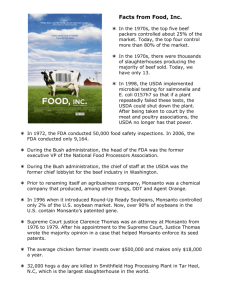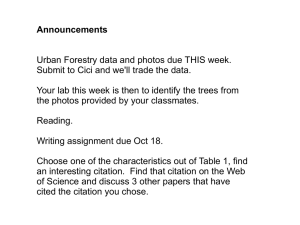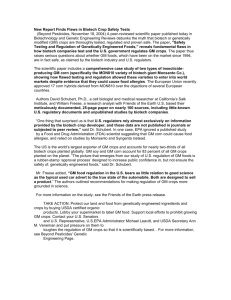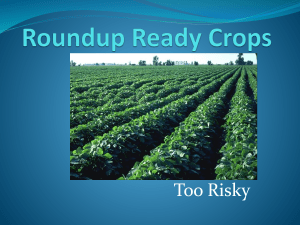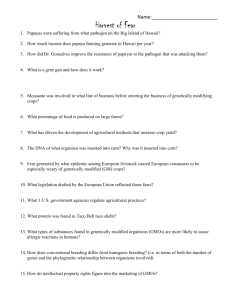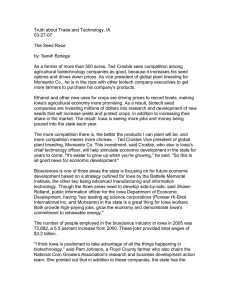Sam Humphrey WRTG-1150 9:00 a.m. Research Outline FACT
advertisement
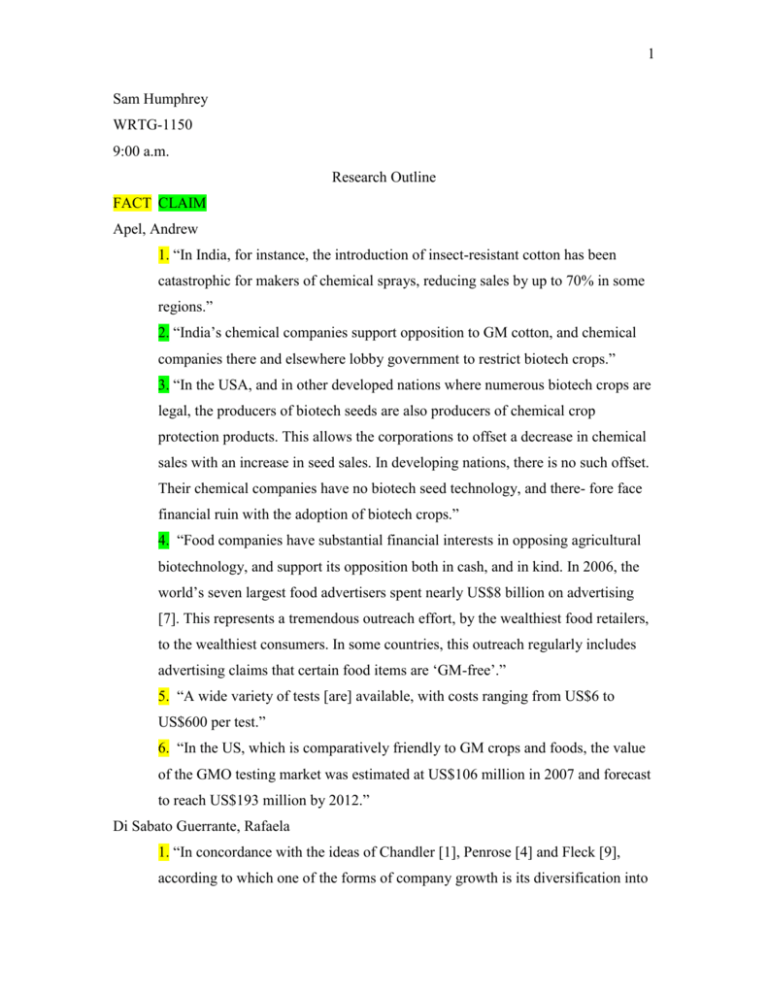
1 Sam Humphrey WRTG-1150 9:00 a.m. Research Outline FACT CLAIM Apel, Andrew 1. “In India, for instance, the introduction of insect-resistant cotton has been catastrophic for makers of chemical sprays, reducing sales by up to 70% in some regions.” 2. “India’s chemical companies support opposition to GM cotton, and chemical companies there and elsewhere lobby government to restrict biotech crops.” 3. “In the USA, and in other developed nations where numerous biotech crops are legal, the producers of biotech seeds are also producers of chemical crop protection products. This allows the corporations to offset a decrease in chemical sales with an increase in seed sales. In developing nations, there is no such offset. Their chemical companies have no biotech seed technology, and there- fore face financial ruin with the adoption of biotech crops.” 4. “Food companies have substantial financial interests in opposing agricultural biotechnology, and support its opposition both in cash, and in kind. In 2006, the world’s seven largest food advertisers spent nearly US$8 billion on advertising [7]. This represents a tremendous outreach effort, by the wealthiest food retailers, to the wealthiest consumers. In some countries, this outreach regularly includes advertising claims that certain food items are ‘GM-free’.” 5. “A wide variety of tests [are] available, with costs ranging from US$6 to US$600 per test.” 6. “In the US, which is comparatively friendly to GM crops and foods, the value of the GMO testing market was estimated at US$106 million in 2007 and forecast to reach US$193 million by 2012.” Di Sabato Guerrante, Rafaela 1. “In concordance with the ideas of Chandler [1], Penrose [4] and Fleck [9], according to which one of the forms of company growth is its diversification into 2 related areas, Monsanto has always sought to diversify into these, taking advantage of its dominance in certain product distribution channels and of the expertise of its personnel, the latter an achievement attained over time, as Penrose asserts, or by means of the contracting of market specialists, an idea which is opposed by her.” 2. “The entry of the company into the food additive market, beginning to produce in 1904 and 1905, respectively, caffeine and vanillin” 3. “The diversification into the pharmaceutical sector and its precursors, marked by the beginning of the production of phenacetin, an analgesic compound, of phenolphthalein, used in laxatives, of glycerol phosphates – present in nervous system tonics -, in 1912; in 1915, of nitrochlorobenzene, a raw material utilized in the synthesis of drugs, and in 1917, by the expiration of the patent held by Bayer in the US for acetylsalicylic acid, which al- lowed Monsanto to add another product to its al- ready very diverse portfolio” 4. “Diversification in 1967, into the following sectors: semiconductor materials, surfaces for sports and recreation, engineered composites, protein foods and graphics systems” 5. “Migration to non-related areas, such as children’s toys for schools and playgrounds, soy- based beverages, and valves and control systems for industrial processes, following acquisition of the US Fisher Governor Company.” 6. “In many of the diversification initiatives under- taken by Monsanto, the company presented re- current behaviors in its attempts to overcome its lack of internal capacities in those areas in which it desired to act or to strengthen its participation. These behaviors consisted of: the acquisition of, or formation of joint ventures with, companies al- ready active in target markets; the absorption of technology by means of licensing of technology packages; and the incorporation of tacit knowledge by hiring of human resources specializing in areas of interest.” With regard to the acquisition of companies, many examples from the company’s history may be cited. Amongst these are: 7. “The purchase, in 1920, of 50% of R. Graesser, a chemical company, leader in the production of phenol in the UK market. At this time, Monsanto perceived the 3 excess of phenol in the post-WW1 US market, the need to find an alternate market for it, and the convenience of integrating it into the production of phenolphthalein. This was Monsanto’s first step into international markets.” 8. “The acquisition, in 1929, of two US industrial plants belonging to Rubber Service Laboratories, specializing in the production of chemical additives used in rubber processing, which allowed Monsanto to commence production of polymerization accelerators and antioxidants, amongst other additives.” 9. “The acquisition in 1955, of the US Lion Oil Company, with the aim of integrating its assets, strengthening its activity in the petroleum sector, since Lion’s nitrogenated products - anhydrous ammonia, nitric acid and ammonium nitrate - could be used as a raw material in the production of Monsanto’s fertilizer. This integration forced the company to turn its attention to the agricultural sector, with the creation of an action plan for the company in this market.” 10. “The acquisition, 1969, of the US Farmers Hybrid Companies, a small group specializing in the production of corn hybrids, this being the first sign of Monsanto’s interest in entering the market for genetically - modified (GM) seeds. Many other acquisitions of seed companies- Jacob Hartz, Agracetus, Agroceres, Anglo - Dutch Unilever, Asgrow Seed, Braskalb, Calgene, Dekalb, Grupo, Maeda, Holden’s Foundation Seed, Limagrain Canada Seeds, Plant Breeding International Cam- bridge (PBIC), Selected International Seeds Operations of Cargill, Sementes Hatã, Seminis, Western Seed and Poloni Semences - would follow this, leading to the company’s consolidation in this area.” 11. “The purchase of G. D. Searle, in 1985, an American pharmaceutical company, holder of the patent for aspartame, which was to expire in 1992. This acquisition provided Monsanto with the capabilities which it needed to establish itself in the pharmaceutical market.” Eisberg, Neil 1. “Swiss agribusiness Syngenta has assumed full ownership of GreenLeaf Genetics, which offers licenses for corn and soya bean genetic material to 4 foundation seed companies and facilitates the licensing of biotech traits. The deal dissolves a joint venture partnership between Syngenta Seeds and Pioneer HiBred, part of US major DuPont. No financial details were disclosed.” Herrera, Stephan 1. “Last January, Monsanto announced its $1.4 billion acquisition of Seminis, a fruit and vegetable seed company from Oxnard, California. Investors and environmentalists rarely agree on anything when it comes to Monsanto, but it seems that the Seminis deal—and on a smaller scale, the $300 mil- lion purchase of the Emergent Genetics cot- ton seed company of Boulder, Colorado in February and the $40 million acquisition of Lincoln, Nebraska–based grain seed firm NC+ Hybrids in March—has brought back bad memories of Monsanto’s exuberant expansion in the late 1990s into the soy and seed corn business.” 2. “After a decade of slow (and in some years, no) growth, in just the past two years, for example, sales of apples, oranges and bananas in the United States have started to recover, according to the US Department of Agriculture. Likewise, leading producers Brazil and the United States, and even niche producers such as New Zealand, have all reported robust growth in exports of both fruits and vegetables to the seemingly insatiable market that is China.” 3. ““I think that Monsanto would be very foolish to bring forward [GM] whole fruits or vegetables,” says Lindsay Keenan, a GM campaigner for Greenpeace International in Amsterdam. “But, Monsanto can clearly benefit by having their patented genes in as many seeds as possible. The company is also quite capable of attempting to intro- duce [GM] fruit and vegetables in markets where it believes it can get away with it like the United States and Canada. Since GM papaya, for example, is only grown in Hawaii, but sold widely in the United States, they might assume that the [fruit] market is wide open.”” Kershen, Drew L. 1. “If science plays a vital role in promoting sustain- able intensive global agriculture, then the Royal Society is guardedly optimistic that the urgent challenge will be met and that the world society will reap the benefits – adequate amounts of nutritious, safe food raised by economically, socially, politically and 5 environmentally acceptable agricultural techniques, among which genetically modified crops will have an important place.” 2. “Scientists have been genetically modifying plants for 25 years, since the early 1980s; developers have commercialized genetically modified crops for 15 years, since the mid-1990s.” 3. “Hundreds of millions of hectares planted and harvested with transgenic crops provide the agronomic evidence that genetically modified crops are simply new crop varieties that present no unique or different risks than crops raised through conventional or organic means.” 4. “Building upon this substantial scientific and agronomic experience, reliable studies have shown that these genetically modified crops have created positive farm income effects, nonpecuniary benefits for farmers in terms of their labor, safety and resources, important yield increases, improved environmental agricultural footprints and marked reductions in green-house gas emissions.” Kim, Sook-Jin 1. The article addresses and walks the reader through the heirloom seeds that were present in South Korea, and how corporations came and took over the industry, and thus tried to remove the heirloom seeds from the market and dominate the market with GM seeds. McHughen, Alan 1. “This dichotomy between medical and agricultural applications of the same technology likely contributed to a common belief in scientific circles that public skepticism of agricultural biotechnology (but not medical biotech) is largely driven by ignorance and that ‘if only we can teach them the science, the public would accept agbiotech as readily as they do medical biotech’. But this is facile, and often incorrect, thinking. As eloquently articulated by Mohr and Topping [1] in a recent review of consumer behavior, the scientific community should not assume consumer skepticism of agbiotech is owing to sheer and simple ignorance.” 2. “Clearly, not all antibiotech sentiments are based on the ignorance of agriculture or of the rDNA technical mechanisms; the motivation in at least some 6 cases seems based primarily on commercial and/or socioeconomic factors, not on health or environmental risk. Such players will cite, for example, concerns such as increased domination of the food supply by private corporations, or the likelihood of benefits of GE crops accruing disproportionately to large rich farmers at the expense of smaller, poorer farmers, or of disrupting the international trade dynamic. Although these issues may be legitimate points for discussion and debate, they are not borne of technical ignorance and they are not scientific risk based threats to health or environment.” McMahon, Karen 1. “If the acquisitions are approved, Syngenta with its NK Brand and Garst and Golden Harvest brands will arguably become the second largest branded seed corn company in the U.S. Syngenta reports its corn market share is 15%. Holding first place is Pioneer Hi-Bred International; it says it has about 40% of the corn hybrid seed market. Monsanto reports it has 14% of the U.S. corn market through its Dekalb and Asgrow brands.” 2. “Monsanto faces other competition, including that from the market leader. Pioneer just purchased the gene research company Verdia and now has its own glyphosate-resistant trait to use in both corn and soybeans. This trait may not be available for five to six years. In the meantime, Pioneer plans to offer its own corn rootworm trait, developed with Dow AgroSciences, in the next couple of years. It already offers corn borer and other insect control that is tolerant to overthe-top applications of Liberty herbicide through Herculex I, another trait developed with Dow.”
